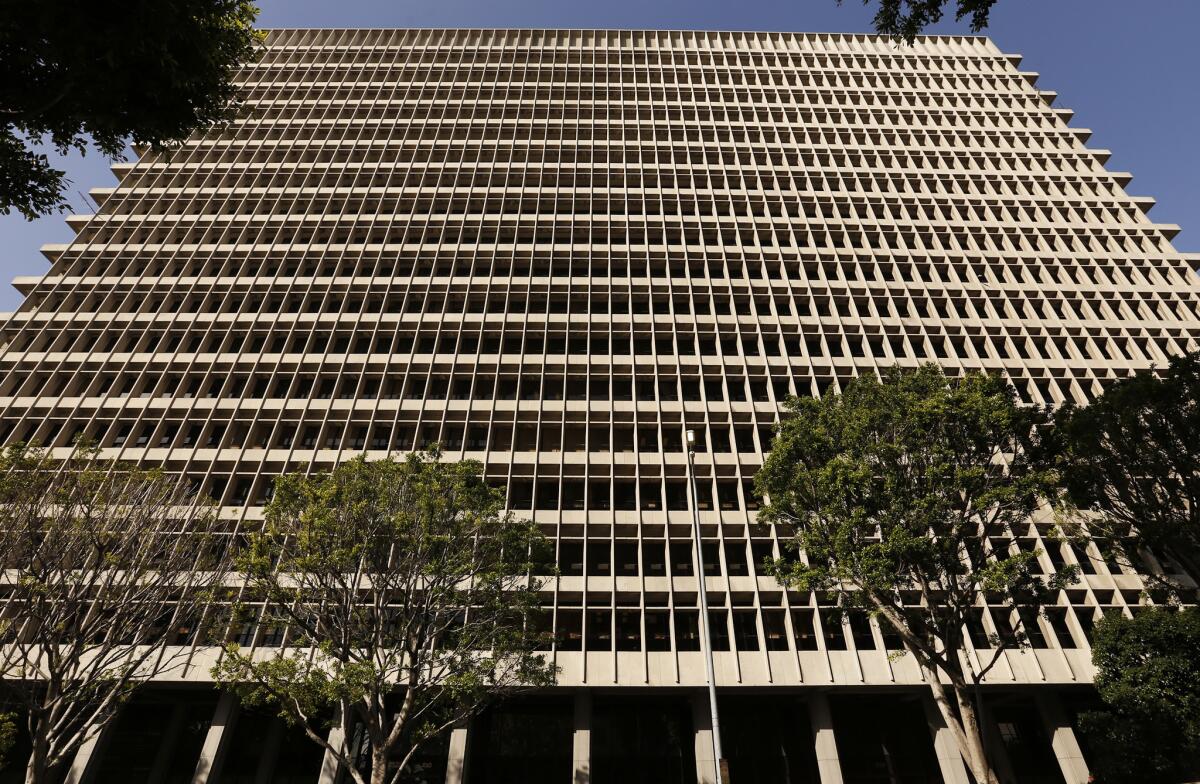Editorial: Los Angeles should help pull its residents out of crisis, not sink them even deeper

Imagine a woman named Monica. She trudges up the steps toward the courthouse door but stops short, overcome by a feeling of dread. Each time she’d walked through that door in the past she’d had to leave behind something of value before she could walk out again.
Once it was the money for next month’s rent, because she had to pay a traffic fine. And then it was her apartment itself, because she was too many months in arrears. And, for a time, it was her freedom, because she was caught stealing in an effort to cobble together another security deposit on a new place. And with her jail term she lost her job, and her only source of income, because of course she was unable to show up for work while she was locked up, and was unable to convince her employer to hire her back when she got out.
Another time she’d had to leave her own father behind in the courtroom, after his mental illness led him into a confrontation with a neighbor and then a police officer. He was now on a sad but common cycle of jail, to release, to the street, to another incident, and back to jail.
And always, Monica walked out of the courthouse after leaving behind a little more of her nearly depleted self-respect. Her dignity. Her hope.
What would she have to leave behind this time? Her children, perhaps. Having lost their apartment, Monica and her two kids shuffled from one friend’s living room to another for a couple weeks at a time before wearing out their welcome and moving on.
Like thousands of real people in her same circumstances, the fictional Monica had nothing to cushion her fall. She had no family, no savings, no support. She now belonged to Los Angeles County — its sheriff’s deputies, its prosecutors, its public defenders, its probation officers, its welfare workers, its courtrooms, its jail cells and finally, perhaps, its streets.
So she stood before the courthouse door, unwilling to walk in. But this time, a woman who looked to be about her age walked out.
“Monica?” she asked. “We’ve been expecting you! I’m Denise. Come on in, we’ve got all kinds of things set up for you!”
This was different, to say the least. Denise did not have the tired look of the overworked courthouse employee, or the badge and uniform of a probation officer. She ushered Monica into a brightly painted room and motioned for her to take a seat.
“First,” Denise told her, “I want to apologize. I’m sorry we let you get to this point. It must be nerve-racking. I know. I’ve been there.”
Denise was a peer counselor, working for a small agency that contracted with the county and the courts to intervene with people in crisis before their problems grew too big to solve. Every courthouse has people in crisis, because crisis is what brings most people to court. They’re in family or criminal court, seeking a domestic violence restraining order and wondering where they will spend the night. They’re in traffic court because they were pulled over without registration and insurance. They’re in dependency court because they couldn’t feed their children and were reported for child neglect. They’re in criminal court because they stole to support a drug habit. They’re in landlord-tenant court, about to get evicted.
In former days, they would walk out of the courthouse, as Monica always had, in some way diminished, and in no shape to fend off the same crisis that got them there in the first place.
This time, though, after meeting with Denise and others, Monica walked out of court with a place to live, an appointment at a treatment center (a counselor would pick her up at her new home and take her there), a mental health worker who prom-ised to look into her father’s case, and two bags of food for her kids. Soon there would be a job referral, rehab — and, with any luck, an end to the endless downward spiral.
Of course, Monica is not real. Thousands of people in her circumstances today end up on the street or in jail, with little hope of rebuilding their lives. Denise is not real either, although there are hundreds of people like her in Los Angeles County who have lived through crisis and have the experience and skill to pinpoint the times and places — the “intercepts” — at which people otherwise hurtling headlong into the costly criminal justice system could be reached.
Full-service courthouse resource centers aren’t real either, nor is a decentralized, health-based community-based system of care that could reach people in crisis long before they even get to a courthouse or are encountered by a law enforcement officer. None of it is real.
But it could be. Los Angeles County is on the cusp of building out a health-based system that eases the burden on jails and the streets, and connects people like Monica with people like Denise — and the resources the county already has that could be put to more effective use. It wouldn’t (and shouldn’t) keep everyone out of the criminal justice system. But for many, it would.
Teams of community service providers, academics, lawyers, health service workers and county experts began meeting last year to craft a plan to pull people out of the downward spiral of crisis and to fix the mistakes that have caused Los Angeles so much grief — failure of the state mental health system, racial inequity, overreliance on police and prosecutors to deal with family, public health and education problems.
The Alternative to Incarceration workgroup, created a year ago by the county Board of Supervisors, presents its report to the board on Tuesday. The plan is ambitious and not without controversy. Following through will require passion and focus — and compromise. The supervisors, community leaders, service providers, the real Monicas and Denises, indeed all of us, have a stake in this rare opportunity to enhance public safety and improve people’s lives.
More to Read
Updates
12:21 p.m. March 8, 2020: Because of an editing error, the opening sentence of this editorial was truncated from “Imagine a woman named Monica” to simply “Monica.” The full sentence has been restored.
A cure for the common opinion
Get thought-provoking perspectives with our weekly newsletter.
You may occasionally receive promotional content from the Los Angeles Times.










